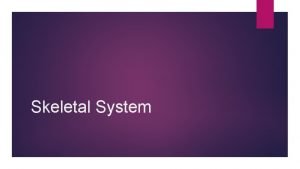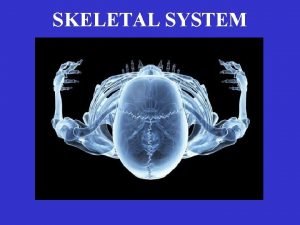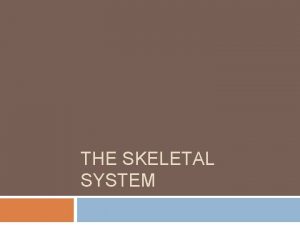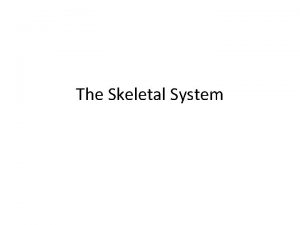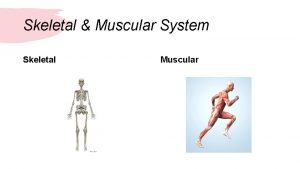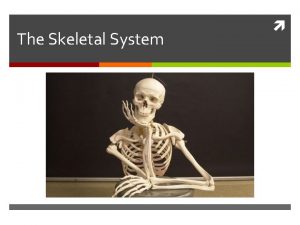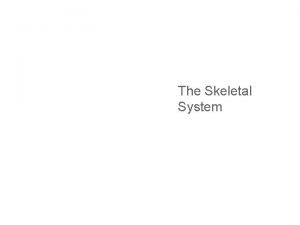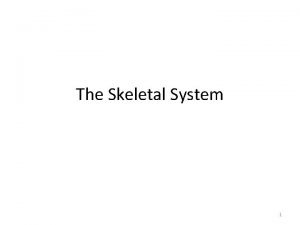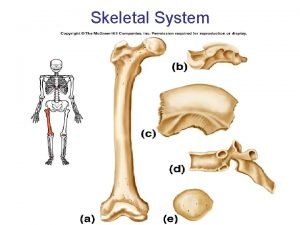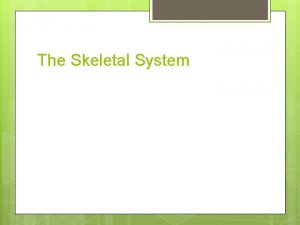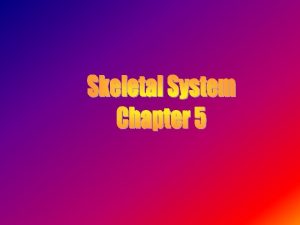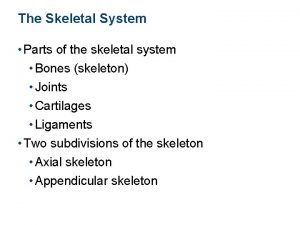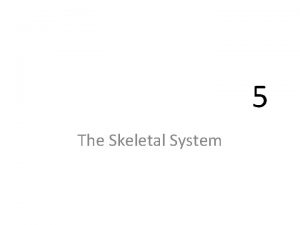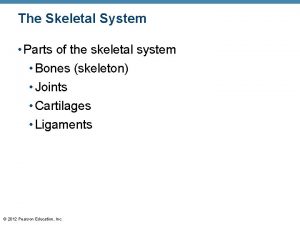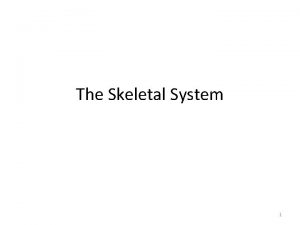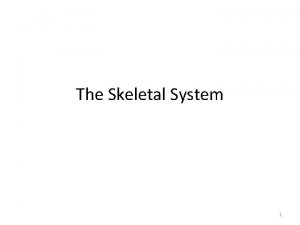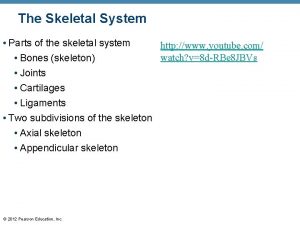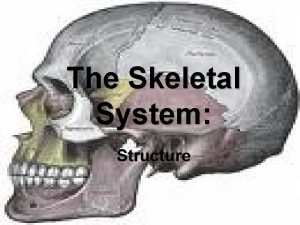The Skeletal System 1 Skeletal System Parts of








































- Slides: 40

The Skeletal System 1

Skeletal System • Parts of the skeletal system: 1. 2. 3. 4. Bones Joints Ligaments Cartilage • Separated into 2 main divisions: 1. Axial 2. Appendicular 2

Review of the Functions of the Skeletal System 1. Support of the body 2. Protection of soft organs – Skull and vertebrae for brain and spinal cord – Rib cage for thoracic cavity organs 3. Movement due to attached skeletal muscles 4. Storage of minerals (Ca+ and P) & fats 5. Blood cell formation (hematopoiesis) 3

Bones of the Human Body • The adult skeleton has 206 bones • 2 basic types of bone tissue: 1. Compact Bone – dense, looks smooth and homogenous; provides strength and stability. 2. Spongy Bone – lattice -like pieces of bone with open spaces; provides shock absorption and flexibility Spongy bone Compact bone Figure 5. 2 b 4

Classification of Bone Shapes • Bones are classified as: – Long – Short – Flat – Irregular Figure 5. 15

Classification of Bone Shapes 6

Classification of Bone Shapes 1. Long bones – longer than they are wide – – Usually shaft w/head at ends Limb bones except wrist and ankle Mostly compound bone Example: Humerus 2. Short bones – cube shaped – Mostly spongy bone – Wrist and ankle – Sesamoid bones are a type of short bone which form within tendons (ex. patella) 7

Classification of Bone Shapes 3. Flat bones – Thin, flat and usually curved – 2 thin layers of flat compound bone sandwiching spongy bone – Ex. Skull, ribs and sternum 4. Irregular bones – miscellaneous – Vertebrae, hip bones 8

Anatomy of a Long Bone Articular cartilage Proximal epiphysis • Diaphysis – shaft of bone – Compact bone – Covered by connective tissue called periosteum Diaphysis Spongy bone Epiphyseal line Periosteum Compact bone Medullary cavity (lined by endosteum) • Epiphysis – ends of bone – Compact bone surrounding spongy bone center Distal epiphysis (a Figure 5. 2 a 9

Where do Long Bones get their strength? • The diaphysis region of a long bone functions to transfer loads more evenly from weight-bearing joint surfaces throughout both the diaphysis and the epiphysis.

Anatomy of a Long Bone • Epiphyseal plate – Flat plate of hyaline cartilage seen in young, growing bone • Epiphyseal line Articular cartilage Proximal epiphysis Diaphysis Spongy bone Epiphyseal line Periosteum Compact bone Medullary cavity (lined by endosteum) – Remnant of the epiphyseal plate – Seen in adult bones Distal epiphysis (a) 11

Changes in the Human Skeleton • In embryos/fetus, the skeleton is primarily hyaline cartilage • During development, much of this cartilage is replaced by bone - ossification • Cartilage remains in isolated areas: – Bridge of the nose – Parts of ribs – Joints 12

Long Bone Formation and Growth Figure 5. 4 a 13

Types of Bone Cells Rickets – disease where bones fail to calcify, legs bow out • Osteocytes -Caused by a lack of vitamin D • Osteoblasts -Bones can also atrophy in bed ridden people – Mature bone cells – Bone-forming cells • Osteoclasts — Giant bone-destroying cells – Break down bone matrix for remodeling and release of calcium (Important for allowing bones to adapt to changes in their weight bearing capacities. ) • Bones are remodeled in response to Ca+ levels in the blood and the pull of gravity and muscles on the bones; such as occurs with activity or exercise. 14

Synovial Fluid • The principal role of synovial fluid is to reduce friction between the cartilage of two bones meeting at joints, especially during movement.

What is a Sprain? • A sprain is an injury to a ligament (the tissue that connects 2+ bones at a joint). In a sprain, one or more ligaments is either over stretched/ extended or torn.
























 Skeleton
Skeleton Hát kết hợp bộ gõ cơ thể
Hát kết hợp bộ gõ cơ thể Ng-html
Ng-html Bổ thể
Bổ thể Tỉ lệ cơ thể trẻ em
Tỉ lệ cơ thể trẻ em Chó sói
Chó sói Chụp phim tư thế worms-breton
Chụp phim tư thế worms-breton Chúa sống lại
Chúa sống lại Môn thể thao bắt đầu bằng từ đua
Môn thể thao bắt đầu bằng từ đua Thế nào là hệ số cao nhất
Thế nào là hệ số cao nhất Các châu lục và đại dương trên thế giới
Các châu lục và đại dương trên thế giới Cong thức tính động năng
Cong thức tính động năng Trời xanh đây là của chúng ta thể thơ
Trời xanh đây là của chúng ta thể thơ Mật thư anh em như thể tay chân
Mật thư anh em như thể tay chân 101012 bằng
101012 bằng Phản ứng thế ankan
Phản ứng thế ankan Các châu lục và đại dương trên thế giới
Các châu lục và đại dương trên thế giới Thể thơ truyền thống
Thể thơ truyền thống Quá trình desamine hóa có thể tạo ra
Quá trình desamine hóa có thể tạo ra Một số thể thơ truyền thống
Một số thể thơ truyền thống Cái miệng xinh xinh thế chỉ nói điều hay thôi
Cái miệng xinh xinh thế chỉ nói điều hay thôi Vẽ hình chiếu vuông góc của vật thể sau
Vẽ hình chiếu vuông góc của vật thể sau Biện pháp chống mỏi cơ
Biện pháp chống mỏi cơ đặc điểm cơ thể của người tối cổ
đặc điểm cơ thể của người tối cổ Ví dụ về giọng cùng tên
Ví dụ về giọng cùng tên Vẽ hình chiếu đứng bằng cạnh của vật thể
Vẽ hình chiếu đứng bằng cạnh của vật thể Phối cảnh
Phối cảnh Thẻ vin
Thẻ vin đại từ thay thế
đại từ thay thế điện thế nghỉ
điện thế nghỉ Tư thế ngồi viết
Tư thế ngồi viết Diễn thế sinh thái là
Diễn thế sinh thái là Dot
Dot Số.nguyên tố
Số.nguyên tố Tư thế ngồi viết
Tư thế ngồi viết Lời thề hippocrates
Lời thề hippocrates Thiếu nhi thế giới liên hoan
Thiếu nhi thế giới liên hoan ưu thế lai là gì
ưu thế lai là gì Sự nuôi và dạy con của hươu
Sự nuôi và dạy con của hươu Khi nào hổ con có thể sống độc lập
Khi nào hổ con có thể sống độc lập Hệ hô hấp
Hệ hô hấp










































